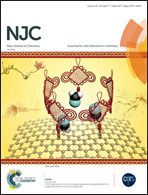Sensitive and selective ratiometric fluorescent detection of monosaccharides in aqueous solutions at physiological pH using self-assembled peptides with different aromatic side chains†
Abstract
The control of disassembly of supramolecular nanostructures of self-assembled peptides by specific stimuli has not been intensively investigated for the fluorescent detection of analytes in aqueous solutions. In the present study, we investigated the control of assembly and disassembly of self-assembled peptides by monosaccharides for ratiometric detection. A series of amphiphilic dipeptides (1–4) with a different aromatic side chain bearing a phenylboronic acid and pyrene fluorophore were synthesized. The dipeptides (1–3) spontaneously self-aggregated and formed nanoparticles in aqueous solutions, resulting in significant pyrene excimer emissions, whereas the dipeptide (4) did not aggregate, resulting in a little excimer emission. The addition of sugars induced the disassembly of the self-aggregates of 1–3, resulting in a decrease in excimer emission and an increase in monomer emission. All peptides (1–4) showed a high selectivity for fructose among monosaccharides and 3 showed the lowest detection limit for fructose among the peptides showed ratiometric responses. The addition of hydrophobic pinanediol stabilized the self-aggregates of 1–3, resulting in an increase in excimer emission and a decrease in monomer emission. Even though 4 did not self-aggregate in aqueous solution, the addition of pinanediol induced the assembly of nanoparticles, resulting in a significant increase of excimer emission and a decrease of monomer emissions. The results revealed that the assembly and disassembly of the self-assembled peptides could be controlled by covalent bonding with sugar, which was suitable for the sensitive ratiometric detection of monosaccharides in aqueous solution at physiological pH.



 Please wait while we load your content...
Please wait while we load your content...